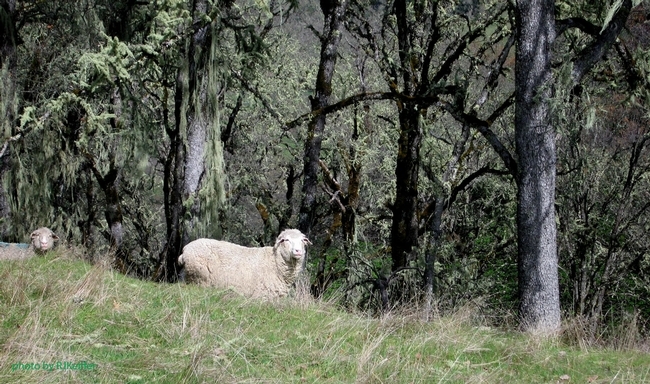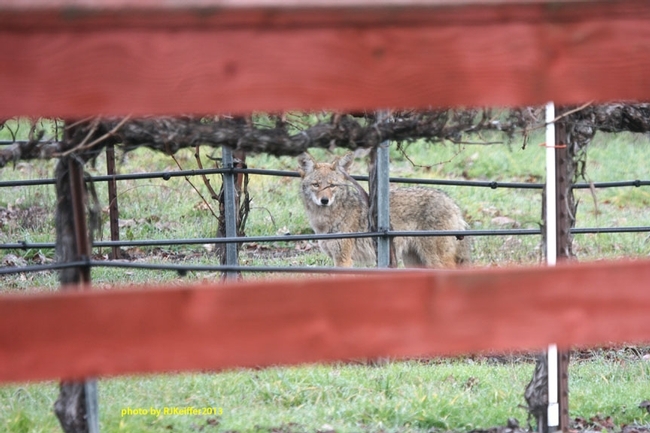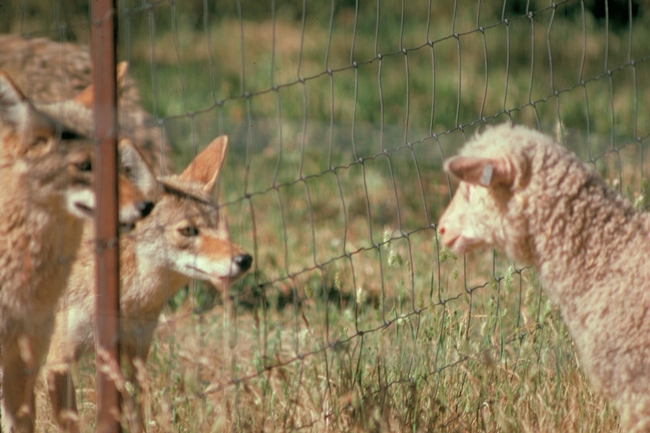Posts Tagged: sheep
'Wild and wooly' sheep shearing class held at Hopland
Many sheep shearing students said the process was "the hardest thing they have ever done," reported Glenda Anderson in the Santa Rosa Press Democrat. The newspaper ran a lengthy feature and a photo gallery of the annual sheep shearing school held at the UC Hopland Research and Extension Center this week.
Reporter Justine Frederiksen of the Ukiah Daily Journal also reported on the sold-out sheep shearing and wool classing training at the 5,300-acre Mendocino County research center.
“And 60 percent of these people had never even touched a sheep before,” said John Harper, UCCE advisor and shearing school leader. Nearly all the students were women and included an artist from San Francisco, a retired fire chief, a UC Davis graduate student, and a woman who was learning to shear ahead of travels to New Zealand “because I think it will be a good skill to have for work, in case I want to stay for a couple of months.”
“One of the things new students have the most trouble with is what we call ‘tipping' the sheep, or flipping them over,” Harper said. He explained that, to get the sheep into the ideal starting position, you need to push its back legs down with one hand and tuck its head in with the other, twisting the animal into a sitting position with all four legs dangling.
UC Hopland REC sheep shearing students are part of a new wave of sheep shearers and wool enthusiasts industry officials hope will reverse decades of disinterest and decline. The shearing classes were booked well ahead of time, said Hannah Bird, a community educator at the research station. Many students are seeking a break from city life or jobs tying them to a desk.
Wrote reporter Glenda Anderson, shearing sheep is sweaty, back-straining work that earns just $2 to $5 per sheep. But an expert sheep shearer taking part in the program said sheep shearing for a living has its benefits.
“It's a lifestyle thing. I could work six months a year and travel around the world,” paying for the travel by working here and there, he said.
Mendocino County no longer to contract with USDA Wildlife Services
Mendocino County supervisors decided to sever ties with the USDA's division of Wildlife Services, reported Peter Fimrite in the San Francisco Chronicle. The decision was made after environmental groups said the agency was indiscriminately killing predators, such as mountain lions and coyotes, because they are a threat to livestock.
The article featured a gallery of 10 artful photos taken at the UC Hopland Research and Extension Center, which maintains a research sheep flock of 500 breeding ewes. Record-keeping of sheep losses to predators began at Hopland in 1973. Coyotes are the most serious predator problem.
Hopland staff use a variety of non-lethal and preventative methods to protect sheep from predators, such as fencing, mob grazing and frequent pasture rotation and guard dogs, according to Kim Rodrigues, the director of the research and extension facility. Currently there are five guard dogs at the center. The guard dogs bond with sheep and protect them primarily by barking and other aggressive behaviors when strangers or predators are near the sheep flock.
Research can help Californians live safely with wildlife
Winter is typically lambing season on Northern California sheep ranches - a perilous time of year. Baby lambs are vulnerable prey for wildlife like coyotes, mountain lions and bears. With increasing numbers of wildlife, both rural and urban neighborhoods are being impacted.
At the UC Hopland Research and Extension Center, we are braced for our first winter under a new policy that minimizes the use of lethal control against native wildlife that prey on our lambs and ewes. As director of the 5,300-acre Mendocino County research facility, I'm nervous for the well-being of our 500 sheep and lambs soon to be born.
The animals are defenseless, therefore it is our responsibility to protect them from predation by wildlife or other animals, such as domestic dogs. Many non-lethal methods of protecting the sheep have been implemented over the past several months. We installed and repaired fences and brought in five new guard dogs to protect the sheep.
Our new practices seemed to work last spring and summer. We can't draw research conclusions from one year of data, but the number of sheep confirmed killed by wild carnivores in 2015 was much smaller than the year before, 10 vs. 48. And the number of coyotes taken so far in 2014 – 15 – was about half the amount in 2014.
I'm encouraged by the numbers. But we want to do better. As a University of California research center, Hopland is the ideal place to study ways for sheep ranchers throughout Northern California to maintain sustainable flocks even in the presence of the growing, and increasingly diverse, wildlife population. At Hopland, we are interested in learning more about how to prevent conflicts with wild animals and reduce the need for lethal control of wildlife. This information will inform policies for wildlife control in cities, rural areas and on ranches.
The Hopland REC was a working sheep ranch when it was purchased by the UC Division of Agriculture and Natural Resources for rangeland and animal management research in 1951. From the 1990s to the 2000s, 10 to 15 percent of lambs or more were killed each year by predators – mainly coyotes – despite aggressive non-lethal and legal lethal control, according to Bob Timm, a UC Cooperative Extension specialist who served as director of the station for 30 years before retiring in 2014.
We will always have predators threatening our sheep. We need research-based information to inform us how to deal with them humanely while maintaining economically viable ranching operations in Mendocino County and throughout California.
Justin Brashares, a professor of wildlife ecology at UC Berkeley, has developed a research plan for the center. We are seeking funding and, in the coming years, will use Hopland as a living laboratory to answer many questions scientists and ranchers have about wildlife in Northern California. The research will help us estimate the wildlife population. We plan to use high-technology GPS collars on prey and predator species to develop very fine-scale information about their interactions. Hopland will also be a site to study the very fencing we and other sheep producers are earnestly installing to protect our sheep from hungry carnivores.
I believe we are lucky to have the wildlife among us. I'm committed to helping our community protect wildlife and raise sheep with research and education programs at Hopland.
We will always have predators threatening our sheep. We need research-based information to inform us how to deal with them humanely while maintaining economically viable ranching operations in Mendocino County and throughout California.
Non-lethal predator wildlife control helps keep livestock safe
Five guard dogs are part of the team protecting sheep at a UC Agriculture and Natural Resources (UC ANR) research center in Mendocino County. The director of the UC Hopland Research and Extension Center (HREC) Kim Rodriguez is optimistic the dogs and other non-lethal wildlife control efforts being used at the station will allow peaceful grazing animals to share land with natural predators, reported Sarah Reith in the Ukiah Daily Journal.
Rodrigues initiated a new standard operating procedure (SOP) at Hopland early this year for predator animal control. The policy involves guard dogs, improved fencing and pasture management to protect sheep from coyotes, rather than shooting the predators. Jim Lewers, senior animal technician at HREC, said the "losses have declined" since the new policy was put in place.
Hannah Bird, HREC community educator, said 10 sheep at the center were killed by coyotes in 2015, while 43 were killed in 2014.
Rodrigues told the reporter that it is hard to attribute declines in animal deaths to a single strategy. She hopes to eventually make Hopland a hub for research and information sharing with local landowners on wildlife control.
That effort begins next week. On Dec. 1 and 2, HREC will offer two separate workshops on wildlife management. The first day will include representatives from USDA Wildlife Services, the California Dept. of Fish and Wildlife, and Defenders of Wildlife. On the second day, local ranchers and UC ANR representatives will speak about their chosen methods of wildlife management. Registration is $30 per day. Registration for the two days is separate, and the deadline is Saturday, Nov. 28.
Click here to register for the Dec. 1 workshop.
Click here to register for the Dec. 2 workshop.
Living with wildlife while managing working landscapes
The UC Hopland Research and Extension Center (UC HREC) will host workshops on Dec. 1 and 2 to foster understanding and encourage community dialog about ranching on a landscape with populations of coyote, black bear, mountain lions and other wildlife.
“Mendocino County supports many ranchers and our communities enjoy locally produced lamb, beef, milk, cheese and other agricultural products,” said Kimberley Rodrigues, director of UC HREC. “Along with these opportunities come challenges associated with living alongside some of our resident wildlife. The workshops will help local residents deal with these challenges.”
Rodrigues – who has a doctorate degree in environmental science and has been a leader in outreach, strategic facilitation and partnership development for 25 years – has been actively involved in wildlife management at the 5,300-acre HREC since she arrived in mid-2014.
“I quickly realized the biggest challenge to maintaining a sustainable flock of sheep here in our location is addressing predation issues, primarily by coyotes,” Rodrigues said. “With some improvements to our fences, changes in pasture rotations and increased use of guard dogs, losses of sheep to coyotes are now at an acceptable level. We hope to share our own experience, hear from diverse perspectives and experiences at these events and would like HREC to become a hub for future learning on this topic.”
Recent discussion and decisions made by the Mendocino County Board of Supervisors regarding their contract with USDA Wildlife Services (WS) and their use of an integrated wildlife damage management program prompted UC HREC to provide a space for two workshops to allow learning on wildlife management and community conversation.
The Dec. 1 workshop will focus on scientific design and is implemented by USDA WS. It provides an opportunity to hear experts from USDA, the Californi Department of Fish and Wildlife, UC Cooperative Extension and Defenders of Wildlife to discuss the most up-to-date research in wildlife behavior and non-lethal control methods.
The Dec. 2 community conversation workshop is hosted by UC HREC and includes current research from UC Agriculture and Natural Resources, wildlife biologists and discussion of the challenges associated with ranching in Mendocino County from the Magruder family and other local ranchers. The day will culminate in discussion groups on topics ranging from integrated wildlife management tools to understanding local, state and federal connections.
The public may attend either day or both days. Registration for the two workshops is separate.
“Topography, surrounding environments, community viewpoints, available funds and the kind of animals being farmed are all part of the picture – there is no easy solution,” said Hannah Bird, UC HREC community educator. “Ranchers and land managers need to know what tools are available to them and the implications and benefits of each of these tools. Attending both workshops will provide a deeper understanding of the issues.”
Community members, ranchers, land managers and members of non-profit organizations are invited to attend. The workshops will be at the Rod Shippey Hall, Hopland Research and Extension Center, 4070 University Road, Hopland, CA 95449. Registration is $30 for each day (including lunch) and must be made in advance. The registration deadline is Nov. 23. Space is limited.
Sign up for the Dec. 1 USDA WS workshop at http://ow.ly/TYhBd and the Dec. 2 community conversation workshop at http://ow.ly/TYhos.
More on the University of California Hopland Research and Extension Center:
The Hopland Research and Extension Center is a multi-disciplinary research and education facility run by the University of California, Agriculture and Natural Resources Division. As stewards of more than 5,300 acres of oak woodland, grassland, chaparral, and riparian environments their mission is to find better ways to manage our natural resources and conduct sustainable agricultural practices, through science, for the benefit of California's citizens.
Author: Hannah Bird






